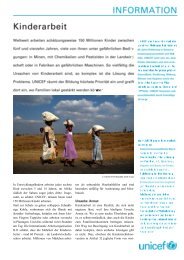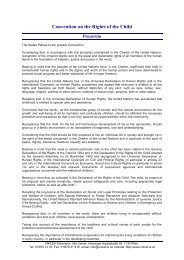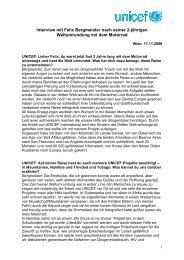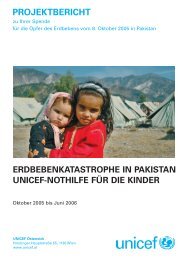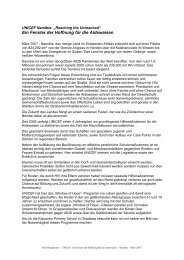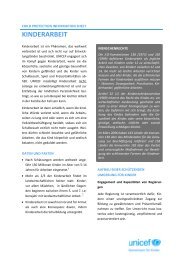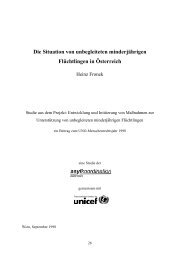Create successful ePaper yourself
Turn your PDF publications into a flip-book with our unique Google optimized e-Paper software.
in their cars. Because of that, I strongly requested that the<br />
new facilities have rooms for mothers and a proper kitchen.<br />
Among the activities for children, cooking is very good<br />
because it teaches them that all things have an order. When<br />
cooking, we gather the ingredients, cook them, and then eat.<br />
In addition, it makes it easy for the mothers to interact. Also,<br />
if another earthquake should happen, it could be used as an<br />
evacuation shelter. The new facilities will have a large hall<br />
where people will be able to stay and have access to cooking<br />
facilities. Therefore, I think it could serve as an emergency<br />
base because evacuees could live under stable conditions.<br />
Right now, we are borrowing the second floor of a<br />
welfare center for the elderly. We are taking care of 12 young<br />
children and 25 primary school children. We’re worried about<br />
injuries so we can’t let them run freely. I am looking forward<br />
to letting them play to their hearts’ content when we move<br />
to the new facilities. Also, we want to give the mothers<br />
more time for independent activities. I would like to have the<br />
mothers be able to live richer lives while also caring for their<br />
disabled child.”<br />
<strong>Report</strong> 5 Sanpo Nursery School<br />
(Fukushima)<br />
Sanpo Nursery School’s building in Iwaki, Fukushima, was<br />
severely damaged by the earthquake. There were innumerable<br />
cracks in the walls and floors, a fissure appeared in the<br />
garden, and some areas caved in because of liquefaction. The<br />
authorities deemed it unusable, noting all the damage done<br />
to the building and the grounds. As there was no other<br />
nursery school to move to, Sanpo Nursery School decided to<br />
restart its activities in a relatively safe room on the first floor<br />
of the building from March 22. In consideration of the circumstances,<br />
JCU decided to support the construction of a temporary<br />
facility for Sanpo Nursery School. After the city of<br />
Iwaki had completed the removal and replacement of the<br />
topsoil in the garden (to remove any possible radioactivity),<br />
construction of the building began in September. The nursery<br />
school was ready to open on November 14.<br />
“At the end of March after the earthquake, we only had<br />
two children wanting to come back to the nursery school,”<br />
said Michiko Abe, the nursery school principal. “However, by<br />
the end of the long holidays in May, 83 children had come<br />
back, and now we are up to 97. Many of the mothers are<br />
young, raising children while<br />
working, and just making ends<br />
meet. In response to their requests,<br />
we looked for a space in community<br />
centers and other public buildings,<br />
but we couldn’t find anything to rent.<br />
I immediately had an architect<br />
assess the damage to our building,<br />
Nursery school principal<br />
Michiko Abe.<br />
Views of the damaged nursery school building<br />
and he reported that the first floor<br />
was relatively sound. So, I had the<br />
17<br />
washroom and the kitchen repaired. We reopened the school<br />
amid the continued aftershocks from the earthquake with a<br />
bus always waiting in the garden to evacuate us if necessary.<br />
“We realized from an early stage that the only options<br />
were to demolish or rebuild the nursery school. However, we<br />
couldn’t make a decision because we didn’t know how many<br />
children would return, or what the impact of the nuclear incident<br />
would be, or what the situation was in the area surrounding<br />
us. The chairman of the council decided that it was<br />
worthwhile rebuilding, based on the number of children who<br />
wanted to return at that time. We decided to take a chance<br />
and build a temporary facility. We discussed financial assistance<br />
from the authorities, but they told us that it would be<br />
difficult to obtain money this fiscal year. After that we didn’t<br />
know what to do for a while. Then, we found out via the Internet<br />
that UNICEF were supporting the rebuilding of facilities.<br />
The vice principal discussed our situation with UNICEF, and<br />
we got a call saying they were going to support us. Of our 26<br />
staff, 17 remained with us. Despite the fact that their own<br />
homes had been destroyed or damaged, they all set to work,<br />
led by the head and vice-head teachers. They did so with a<br />
sense of mission: they believed that only they could protect<br />
the lives of the children.<br />
Thanks to UNICEF building us a new temporary facility,<br />
we began to see some hope of moving forward based on the<br />
foothold they had given us. We are truly grateful. They have<br />
offered the extension of the lease, but we don’t want to take<br />
advantage of UNICEF’s kindness any more than necessary.<br />
So we are now planning to have the city demolish the old<br />
building by the end of March 2012 and have a permanent<br />
facility built within two years.”<br />
“Thank you, everybody!” from children at the completed temporary facility.<br />
Children going on their first walk from the new facilities.



